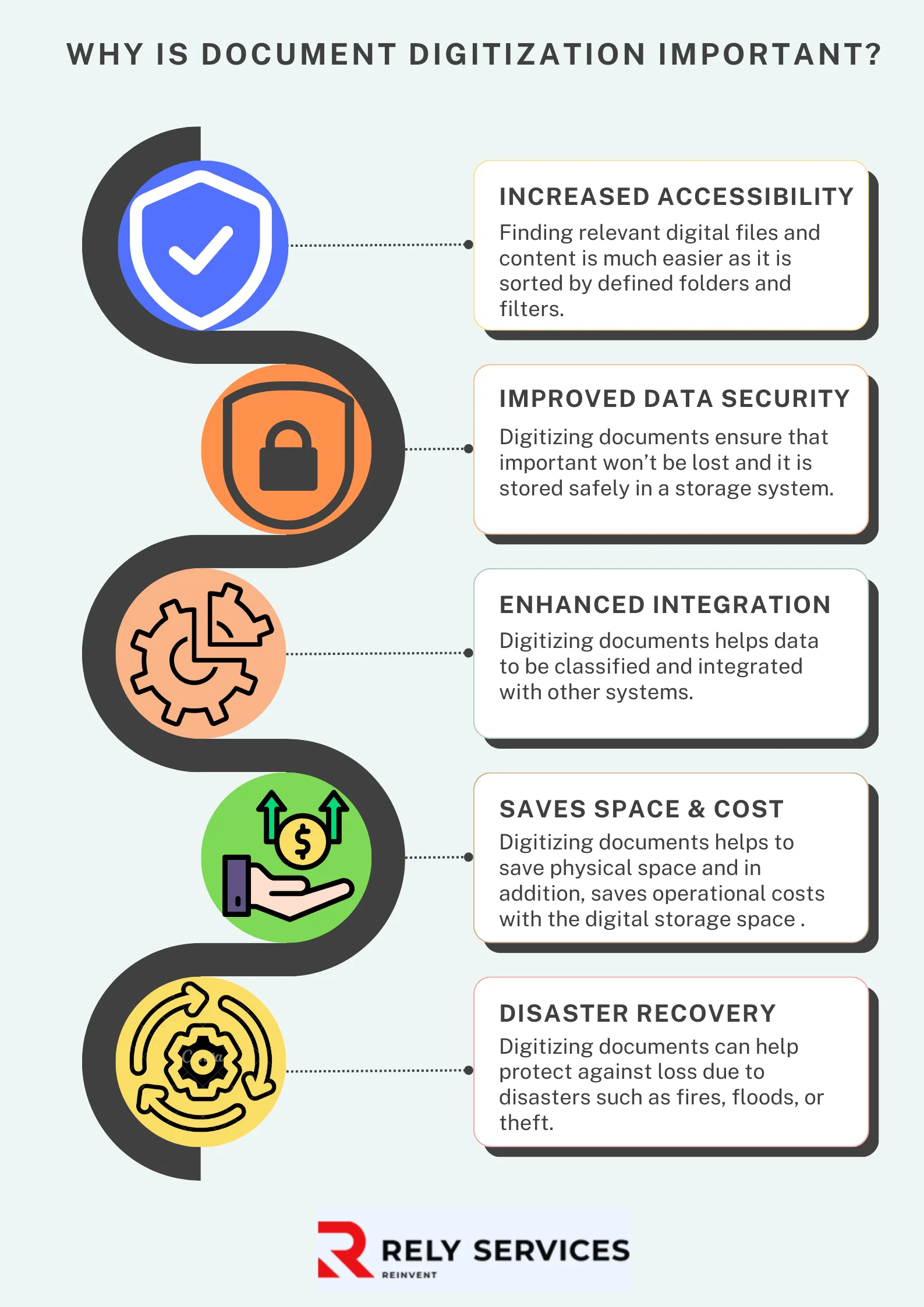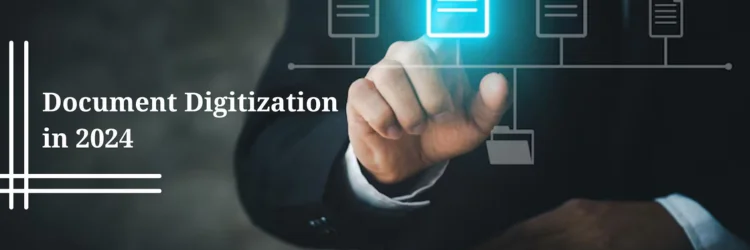Converting paper documents to digital formats is a top priority for businesses. Document digitization solutions, often using OCR (Optical Character Recognition), help turn physical paperwork into digital files. This makes storing, organizing, and protecting important information much easier.
Going digital brings many benefits, including increased security that prevents loss or damage, easier sharing and collaboration even when working remotely, and improved efficiency and competitiveness. In 2024, companies embracing document digitization are well-positioned for success in a rapidly changing business landscape.
What is Document Digitization?
Document digitization is the process of converting paper documents into digital formats using technologies like OCR (Optical Character Recognition). It involves scanning, indexing, and storing documents electronically, making them easily accessible and searchable. OCR services automatically extract text from scanned documents, enabling efficient indexing and search capabilities.
Digitization streamlines operations reduces physical storage needs, enhances data security, and facilitates remote access and collaboration. As businesses adapt to the digital landscape, document digitization is revolutionizing information management for a more efficient and sustainable future.
How Document Digitization Works?
Document digitization is a multi-step process that converts physical paper documents into digital formats. Here's a breakdown of how it works:
1. Preparation: Before scanning, documents are prepared by removing staples, sorting them by type or category, and ensuring they are in good condition. This step streamlines the scanning process and improves the quality of the digital output.
2. Scanning: The prepared documents are then scanned using high-quality scanners or document digitization services. These scanners capture the visual information from paper documents and convert it into digital images, such as TIFF or PDF files.
3. Pre-processing: Once scanned, the digital images undergo pre-processing to enhance their quality. This may include cropping, de-skewing, and adjusting the brightness and contrast. Pre-processing ensures that the digital documents are clear, readable, and ready for further processing.
4. Data extraction: After pre-processing, the digital images are analyzed using OCR (Optical Character Recognition) technology. It recognizes and extracts the text from the scanned documents, converting the images into machine-readable text. It enables the digitized documents to be searchable and editable.
5. Indexing and storage: The extracted data is then indexed based on predefined categories or metadata, such as document type, date, or keywords. Indexing allows for quick and efficient retrieval of specific documents when needed. Finally, the digitized documents and their associated metadata are stored in a secure digital repository or document management system for easy access and management.
By following these steps, it transforms physical paper documents into organized, searchable, and easily accessible digital assets. This process streamlines document management, improves efficiency, and enhances data security for businesses and organizations.

Why Is Digitization of Documents Important?
Digitization of documents is crucial for businesses and organizations in today's digital age. Here are some key reasons why it is so important:
1. Increased searchability and accessibility: Digitized documents are easily searchable using keywords, tags, or metadata. This makes it simple for employees to find the information they need quickly, without having to sift through countless paper files. Additionally, digitized documents can be accessed from anywhere, at any time, using various devices, enhancing accessibility and flexibility.
2. Improved data security: Digital documents can be protected with various security measures, such as encryption, password protection, and user access controls. This ensures that sensitive information remains secure and confidential, reducing the risk of data breaches or unauthorized access. Moreover, digital documents can be backed up regularly, preventing data loss due to physical damage or theft.
3. Enhanced integration and collaboration: Digitized documents can be seamlessly integrated with other digital tools and systems, such as enterprise resource planning (ERP) software or customer relationship management (CRM) platforms. This integration enables smooth data flow and eliminates the need for manual data entry. Furthermore, digital documents facilitate collaboration among team members, as they can be easily shared, edited, and commented on in real time, regardless of location.
4. Saves space and costs: Storing physical paper documents requires significant space and can be costly in terms of rent, maintenance, and storage equipment. By digitizing documents, businesses can dramatically reduce their physical storage needs, freeing up valuable office space and lowering storage costs. Additionally, digital document management eliminates the need for paper, ink, and printing, leading to further cost savings.
5. Disaster recovery: Physical documents are vulnerable to natural disasters, such as fires, floods, or earthquakes, which can result in permanent data loss. By digitizing documents and storing them in the cloud or on secure servers, businesses can ensure that their critical information remains safe and recoverable in the event of a disaster. This helps maintain business continuity and minimizes the impact of unforeseen events on the organization.
In summary, It is essential for businesses looking to improve efficiency, enhance security, facilitate collaboration, save costs, and ensure business continuity. As the world continues to embrace digital transformation, digitizing documents has become a strategic imperative for organizations across industries.
What are the Top Document Processing Challenges?
While document digitization offers numerous benefits, businesses may face several challenges during the process. Here are some of the top document processing challenges:
1. Inadequacy: Inadequate or outdated document processing systems can hinder the digitization process. Legacy systems may lack the necessary features, integration capabilities, or scalability to handle the volume and complexity of documents, leading to inefficiencies and bottlenecks.
2. Price: Implementing comprehensive document digitization solutions can be costly, especially for small and medium-sized businesses. The initial investment in hardware, software, and training can be substantial, and ongoing maintenance and upgrades can add to the overall expenses.
3. Storage in physical form: Storing documents in physical form can be a significant challenge. Physical storage requires space, which can be expensive, especially in urban areas. Additionally, physical documents are susceptible to damage from environmental factors like humidity, fire, or flooding.
4. Poor visibility: Without proper indexing and metadata, digitized documents can be difficult to locate and retrieve. Poor visibility can lead to wasted time searching for specific documents, hindering productivity and decision-making processes.
5. Risk: It involves handling sensitive and confidential information, which can pose security risks if not managed properly. Inadequate security measures, such as a lack of encryption or access controls, can leave digitized documents vulnerable to unauthorized access, data breaches, or cyber threats.
How Outsourcing Partners Handle the Challenges of Document Digitization?
Outsourcing partners play a crucial role in helping businesses overcome the challenges associated with document digitization. Here's how they address these challenges:
Solution 1. Assess Existing Procedures
It begins by thoroughly assessing the client's existing document management procedures. They identify inefficiencies, bottlenecks, and areas for improvement. By understanding the current processes, they can develop a tailored digitization strategy that aligns with the client's specific needs and goals.
Solution 2. Make an Automation Investment
Outsourcing allies invest in advanced automation technologies to streamline the process. They utilize OCR software, intelligent data capture solutions, and robotic process automation (RPA) to automate repetitive tasks, reduce manual errors, and improve overall efficiency. This automation investment ensures that the digitization process is fast, accurate, and cost-effective.
Solution 3. Create a Standard Format for Documents
They work with clients to establish a standard format for digitized documents. They develop a consistent naming convention, file structure, and metadata schema to ensure easy searchability and retrieval. By creating a standardized format, they eliminate confusion and inconsistencies, making it easier for users to locate and access the required documents.
Solution 4. Strengthen the Control of Data Quality
Outsourcing partners implement robust quality control measures to ensure the accuracy and integrity of digitized data. They employ data validation techniques, double-key entry, and manual verification to catch and correct any errors or inconsistencies. By strengthening data quality control, they minimize the risk of inaccurate or incomplete information, which can have serious consequences for business operations.
Solution 5. Give Integration First Priority
They prioritize integration when implementing document digitization solutions. They ensure that the digitized documents seamlessly integrate with the client's existing systems, such as enterprise resource planning (ERP), customer relationship management (CRM), or content management systems (CMS). By giving integration priority, they enable smooth data flow, eliminate silos, and facilitate efficient collaboration across departments.
By addressing these challenges through a combination of assessment, automation, standardization, quality control, and integration, outsourcing partners help businesses successfully navigate the complexities of document digitization. They bring expertise, technology, and best practices to the table, enabling organizations to reap the benefits of digitization while minimizing risks and ensuring a smooth transition to a paperless environment.
Digitize your Documents with Rely Services Experts
It is no longer a choice but a necessity, and by partnering with Rely Services Experts, you can transform your paper-based documents into easily accessible, secure, and searchable digital assets. Our team of experienced professionals leverages cutting-edge technology and proven methodologies to streamline your document management processes, enhance efficiency, and unlock the full potential of your information.
Don't let outdated paper documents hold your business back. Take the first step towards a smarter, more agile future and contact Rely Services Experts today to embark on your document digitization journey.

Leave A Reply